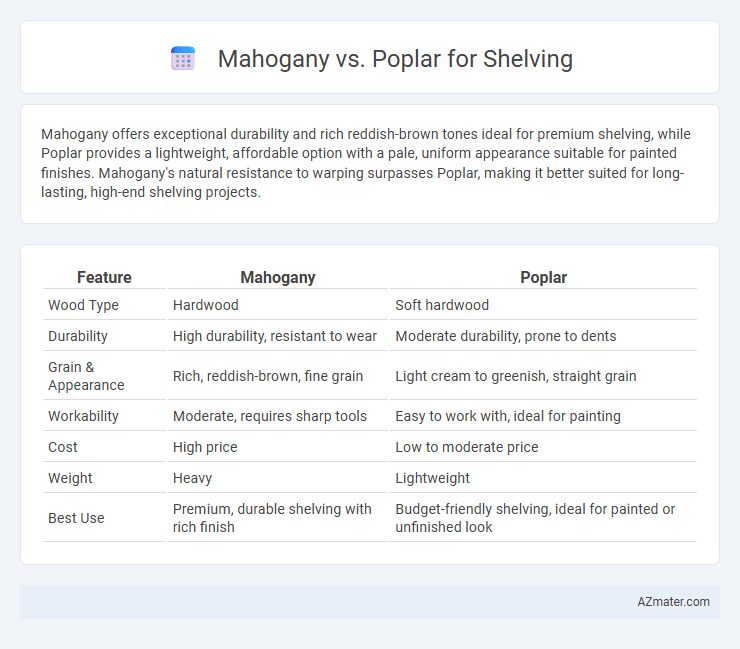Mahogany offers exceptional durability and rich reddish-brown tones ideal for premium shelving, while Poplar provides a lightweight, affordable option with a pale, uniform appearance suitable for painted finishes. Mahogany's natural resistance to warping surpasses Poplar, making it better suited for long-lasting, high-end shelving projects.
Table of Comparison
| Feature | Mahogany | Poplar |
|---|---|---|
| Wood Type | Hardwood | Soft hardwood |
| Durability | High durability, resistant to wear | Moderate durability, prone to dents |
| Grain & Appearance | Rich, reddish-brown, fine grain | Light cream to greenish, straight grain |
| Workability | Moderate, requires sharp tools | Easy to work with, ideal for painting |
| Cost | High price | Low to moderate price |
| Weight | Heavy | Lightweight |
| Best Use | Premium, durable shelving with rich finish | Budget-friendly shelving, ideal for painted or unfinished look |
Introduction to Mahogany and Poplar for Shelving
Mahogany is a dense, durable hardwood renowned for its rich, reddish-brown color and natural resistance to decay, making it an excellent choice for high-end, long-lasting shelving. Poplar, a lightweight and less expensive hardwood, offers a pale, creamy appearance that takes paint well but lacks the natural strength and resistance of mahogany. Choosing between mahogany and poplar depends on the desired shelf aesthetics, durability requirements, and budget considerations.
Wood Characteristics: Mahogany vs Poplar
Mahogany features a dense, fine-grain structure with a rich reddish-brown color, offering exceptional durability and resistance to wear, making it ideal for high-end shelving projects. Poplar is lighter with a pale, creamy white to light green hue and a softer texture, which is easier to work with but less resistant to dents and scratches. The distinct hardness and natural color variations of mahogany create a more luxurious finish, while poplar's affordability and smooth grain make it suitable for painted or budget-conscious shelving solutions.
Durability and Strength Comparison
Mahogany offers superior durability and strength compared to poplar, making it ideal for heavy-duty shelving that requires long-term stability. Poplar is softer and more prone to dents and scratches, which reduces its lifespan under significant weight or frequent use. For robust shelving, mahogany's dense grain structure provides enhanced resistance to warping and wear, ensuring greater structural integrity over time.
Appearance and Aesthetics
Mahogany features a rich, reddish-brown hue with a fine, straight grain that imparts a luxurious and timeless appearance ideal for high-end shelving. Poplar, by contrast, exhibits a lighter, creamy tone with subtle green or brown streaks and a more uniform grain, offering a versatile and understated look that works well in painted or stained finishes. The deep, warm color of mahogany enhances classic and traditional decor, while poplar's neutral palette complements modern and casual styles.
Weight and Workability Differences
Mahogany is denser and heavier, with a typical density of around 0.6-0.85 g/cm3, compared to poplar's lighter density of approximately 0.4-0.5 g/cm3, making poplar easier to handle and install for shelving. Poplar boasts superior workability due to its softer grain, allowing for easier cutting, shaping, and sanding, while mahogany's tight grain offers excellent durability but requires sharper tools and more effort. Choosing between mahogany and poplar impacts the shelf's weight support capacity and installation ease, with mahogany better suited for heavy-duty shelves and poplar ideal for lightweight, more intricate projects.
Cost and Availability Analysis
Mahogany is a premium hardwood known for its rich color and durability, but it comes with a higher price tag, often costing three to four times more than poplar. Poplar, a more common and widely available soft hardwood, offers affordability and easier access, making it a popular choice for budget-conscious shelving projects. Availability of mahogany is limited due to controlled harvesting and environmental regulations, while poplar's abundance in North America ensures consistent supply for woodworking needs.
Finish and Maintenance Requirements
Mahogany offers a rich, deep finish that enhances over time with minimal maintenance, requiring only occasional polishing to preserve its natural luster. Poplar, in contrast, has a lighter, softer finish that often needs a primer and paint to achieve a durable, smooth surface and demands more frequent touch-ups due to its porous nature. Choosing mahogany for shelving provides a long-lasting, low-maintenance aesthetic, while poplar requires consistent care to maintain its appearance.
Environmental Impact and Sustainability
Mahogany is a slow-growing hardwood often harvested from tropical forests, raising concerns over deforestation and habitat loss, though certified sustainably sourced options exist. Poplar is a fast-growing, renewable softwood typically grown in managed plantations, making it a more environmentally sustainable choice with a smaller carbon footprint. Choosing poplar for shelving supports sustainable forestry practices and reduces the impact on endangered ecosystems compared to mahogany.
Best Applications: Mahogany vs Poplar Shelves
Mahogany excels in high-end shelving applications due to its rich color, durability, and resistance to warping, making it ideal for decorative and heavy-duty shelves in living rooms or libraries. Poplar offers a cost-effective alternative for painted shelves, favored in closets or utility spaces where affordability and smooth finish are priorities. Both woods provide sturdy support, but mahogany's superior density suits visible, premium installations while poplar's versatility fits budget-conscious, functional shelving projects.
Choosing the Right Wood for Your Shelving Project
Mahogany offers a rich, durable hardwood option with a smooth grain and natural resistance to decay, making it ideal for high-end, long-lasting shelving projects requiring strength and aesthetic appeal. Poplar is a more affordable, lightweight wood that is easy to work with and takes paint well, perfect for budget-conscious shelving where customization and ease of installation are priorities. Selecting between mahogany and poplar depends on balancing factors like durability, cost, finish preference, and the intended shelf use in your project.

Infographic: Mahogany vs Poplar for Shelving
 azmater.com
azmater.com